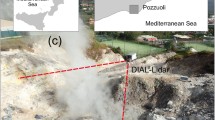Abstract
Volcanic gases give information on magmatic processes. In particular, anomalous releases of carbon dioxide precede volcanic eruptions. Up to now, this gas has been measured in volcanic plumes with conventional measurements that imply the severe risks of local sampling and can last many hours. For these reasons and for the great advantages of laser sensing, the thorough development of volcanic lidars has been undertaken at ENEA (Italian National Agency for New Technologies, Energy and Sustainable Economic Development). In fact, lidar profiling allows one to scan remotely volcanic plumes in a fast and continuous way, and with high spatial and temporal resolution. A differential absorption lidar instrument will be presented in this paper: BILLI (BrIdge voLcanic LIdar). It is based on injection-seeded Nd:YAG laser, double-grating dye laser, difference frequency mixing and optical parametric amplifier. BILLI is funded by the ERC (European Research Council) project BRIDGE (BRIDging the gap between Gas Emissions and geophysical observations at active volcanos). It scanned the gas emitted by Pozzuoli Solfatara (Naples, Italy) and Stromboli Volcano (Sicily, Italy) during field campaigns carried out from October 13 to 17, 2014, and from June 24 to 29, 2015, respectively. Carbon dioxide concentration maps were retrieved remotely in few minutes in the crater areas. To our knowledge, it is the first time that carbon dioxide in a volcanic plume is retrieved by lidar. This result represents the first direct measurement of this kind ever performed on active volcanos and shows the high potential of laser remote sensing in early detection of volcanic hazard.




Similar content being viewed by others
References
Aiuppa A, Burton M, Caltabiano T, Giudice G, Guerrieri S, Liuzzo M, Murè F, Salerno G (2010) Unusually large magmatic CO2 gas emissions prior to a basaltic paroxysm. Geophys Res Lett 37: paper L17303, 5pp
Aiuppa A, Fiorani L, Santoro S, Parracino S, Nuvoli M, Chiodini G, Minopoli C, Tamburello G (2015) New ground-based lidar enables volcanic CO2 flux measurements. Sci Rep 5: paper 13614, 12pp
Fiorani L (2010) Lidar application to lithosphere, hydrosphere and atmosphere. In: Koslovskiy VV (ed) Progress in laser and electro-optics research. Nova, New York, pp 21–75
Fiorani L, Colao F, Palucci A (2009) Measurement of Mount Etna plume by CO2-laser-based lidar. Opt Lett 34:800–802
Fiorani L, Colao F, Palucci A, Poreh D, Aiuppa A, Giudice G (2011) First-time lidar measurement of water vapor flux in a volcanic plume. Opt Commun 284:1295–1298
Fiorani L, Saleh WR, Burton M, Puiu A, Queißer M (2013) Spectroscopic considerations on DIAL measurement of carbon dioxide in volcanic emissions. J Optoelectron Adv M 15:317–325
Fiorani L, Santoro S, Parracino S, Nuvoli M, Minopoli C, Aiuppa A (2015) Volcanic CO2 detection with a DFM/OPA-based lidar. Opt Lett 40:1034–1036
Koch GJ, Beyon JY, Gibert F, Barnes BW, Ismail S, Petros M, Petzar PJ, Yu J, Modlin EA, Davis KJ, Singh UN (2008) Side-line tunable laser transmitter for differential absorption lidar measurements of CO2: design and application to atmospheric measurements. Appl Opt 47:944–956
Linstrom PJ, Mallard WG (2001) The NIST Chemistry WebBook: a chemical data resource on the Internet. J Chem Eng Data 46:1059–1063
Menzies RT, Tratt DM (2003) Differential laser absorption spectrometry for global profiling of tropospheric carbon dioxide: selection of optimum sounding frequencies for high-precision measurements. Appl Opt 42:6569–6577
Queißer M, Burton M, Fiorani L (2015) Differential absorption lidar for volcanic CO2 sensing tested in an unstable atmosphere. Opt Express 23:6634–6644
Rothman LS, Gordon IE, Barbe A, Benner DC, Bernath PF, Birk M, Boudon V, Brown LR, Campargue A, Champion J-P, Chance K, Coudert LH, Dana V, Devi VM, Fally S, Flaud J-M, Gamache RR, Goldman A, Jacquemart D, Kleiner I, Lacome N, Lafferty WJ, Mandin J-Y, Massie ST, Mikhailenko SN, Miller CE, Moazzen-Ahmadi N, Naumenko OV, Nikitin AV, Orphal J, Perevalov VI, Perrin A, Predoi-Cross A, Rinsland CP, Rotger M, Šimečková M, Smith MAH, Sung K, Tashkun SA, Tennyson J, Toth RA, Vandaele AC, VanderAuwera J (2009) The HITRAN 2008 molecular spectroscopic database. J Quant Spectrosc Radiat Transf 110:533–572
Weibring P, Edner H, Svanberg S, Cecchi G, Pantani L, Ferrara R, Caltabiano T (1998) Monitoring of volcanic sulphur dioxide emissions using differential absorption lidar (DIAL), differential optical absorption spectroscopy (DOAS), and correlation spectroscopy (COSPEC). Appl Phys B 67:419–426
Acknowledgments
The authors are grateful to ENEA, in general, and Aldo Pizzuto, Roberta Fantoni and Antonio Palucci, in particular, for constant encouragement. They warmly thank Maria Sarcì, Dario Sisia and Raimondo Spadaro of ENEL for hosting BILLI inside the fence of the power plant and for electrical power. The support from the ERC project BRIDGE, No. 305377, is gratefully acknowledged.
Author information
Authors and Affiliations
Corresponding author
Rights and permissions
About this article
Cite this article
Fiorani, L., Santoro, S., Parracino, S. et al. Early detection of volcanic hazard by lidar measurement of carbon dioxide. Nat Hazards 83 (Suppl 1), 21–29 (2016). https://doi.org/10.1007/s11069-016-2209-0
Received:
Accepted:
Published:
Issue Date:
DOI: https://doi.org/10.1007/s11069-016-2209-0




